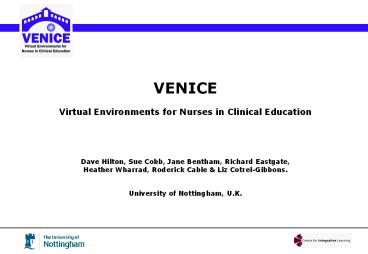VENICE - PowerPoint PPT Presentation
1 / 26
Title:
VENICE
Description:
Dave Hilton, Sue Cobb, Jane Bentham, Richard Eastgate, ... School of Nursing, Midwifery and Physiotherapy has an annual intake of ... – PowerPoint PPT presentation
Number of Views:94
Avg rating:3.0/5.0
Title: VENICE
1
VENICE Virtual Environments for Nurses in
Clinical Education Dave Hilton, Sue Cobb,
Jane Bentham, Richard Eastgate, Heather Wharrad,
Roderick Cable Liz Cotrel-Gibbons. University
of Nottingham, U.K.
2
The VENICE project is a collaboration between
teaching staff and virtual reality researchers at
the University of Nottingham, UK. It is
supported by the Centre for Integrative Learning
at the University of Nottingham.
3
We are currently developing 3D simulations of
clinical environments and clinical tasks. These
are being designed for undergraduate student
nurses to help them to learn and practise
clinical skills. These are being designed as
non-immersive desktop virtual environments.
4
The University of Nottingham School of Nursing,
Midwifery and Physiotherapy has an annual intake
of approximately 800 students.
5
With such large intakes of nursing students,
teaching and assessing clinical skills is very
resource intensive in terms of space, equipment,
time and teaching staff.
6
Physical simulations of clinical environments are
currently used for teaching and assessing however
this takes time to set up and run repeatedly.
7
We considered using computer simulations of the
ward environment in the form of desktop virtual
reality.
8
A Virtual Reality (VR) simulation allows learners
to practice potentially hazardous tasks in a safe
and controlled environment. The environments are
ecologically valid.
The Virtual Factory (Cobb and Brown, 1997)
9
VR simulations are easy to set up and re-use.
They can be used at a time and place to suit
the learner. Errorless learning can be
facilitated through cueing.
10
Which clinical skills would teaching staff
consider to be suitable for a VR simulation?
11
Early prototypes were presented at various
teaching innovations seminars to generate ideas
and gather perspectives from teaching staff.
12
The response was that teaching staff are very
positive about the use of desktop simulations for
teaching clinical skills that require cognitive
tasks such as remembering sequences and making
choices.
13
Infection control, drug administration,
demonstrating medical equipment and wound
management were initial ideas for the
application of the virtual clinical environment.
14
Of these we chose to simulate a number of
infection control scenarios.
15
Infection control is a major problem in UK
hospitals. The incidence of this in some
hospitals in the U.K is as high as 10.
16
- Twelve hazards were devised based upon those
scenarios taught at some of the Schools
education centres. These include - Blood, vomit or urine on the floor
- Bloodstained or dirty linen in bed or on a
trolley - Syringe and needle left on patients table
- Dirty tissues on table
- Broken glass on floor
17
Some models were constructed using Autodesk 3D
Studio Max
18
Some models are were purchased using funding from
the Centre for Integrative Learning
19
Object behaviours were added using a VR
development tool called Virtools.
20
Ward showing hazards
21
The environment during actual use
22
Delivery... The VIRTOOLS based environment is
then converted into a webpage. A web player is
required and this can be downloaded from 3DVIA.
23
The web based virtual environment is then
delivered using WebCT. An accompanying handbook
with questions about infection control is being
developed.
24
User-centred design... Teaching staff and
student nurses contribute to the design process,
actively influencing and advising during all
stages of design rather than passively evaluating
a finished product.
25
As a teaching tool... We are promoting the
virtual ward as teaching resource for lecturers.
The environment can be used to demonstrate
clinical procedures using interactive whiteboards
.
26
As a research and learning tool... We intend to
investigate whether students can use the virtual
environment as a resource for learning clinical
skills. This is planned to take place in Summer
2009.






![READ [PDF] A History of Venice PowerPoint PPT Presentation](https://s3.amazonaws.com/images.powershow.com/10115944.th0.jpg?_=20240901107)





![[PDF] DOWNLOAD The Merchant of Venice PowerPoint PPT Presentation](https://s3.amazonaws.com/images.powershow.com/10095178.th0.jpg?_=202408100311)


















